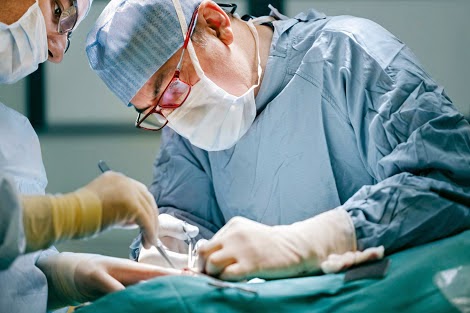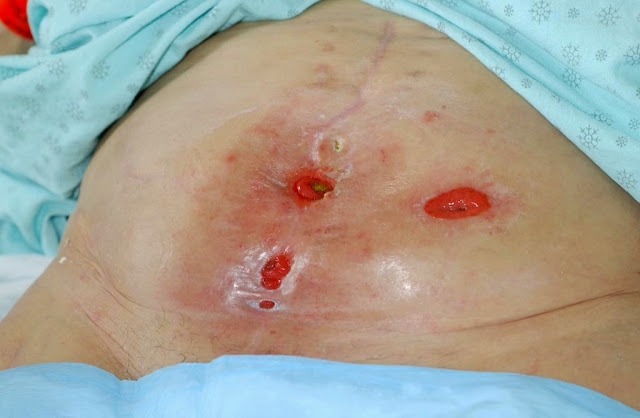Microbiology Mnemonics
Meningitis: most common organisms NHS:
Neisseria meningitidis
Hemophilus Influenzae
Streptococcus pneumonia
·The cause of the most Severe meningitis is Streptococcus.
· Note: NHS is an acronym for National Health Service in several countries.
Syphilis vs. H. ducreyi (chancroid): which ulcer is painful
"In du-crey-i, you do cry (because it is painful)":
In H. ducreyi, the ulcer is painful, in syphilis the ulcer is painless.
Diphtheria toxin properties ABCDEF:
A/B-type toxin. Made by
Corynebacterium diphtheriae, which binds to
EF-2 (elongation factor 2).
RNA viruses: negative stranded "Always Bring
Polymerase Or Fail Replication":
Arena
Bunya
Paramyxo
Orthomyxo
Filo
Rhabdo
· Note: Negative RNA viruses need there own polymerase.
Picorna viridae: members PEECoRnA (Picorna is
pronounced 'pee-corna')
Poliovirus
Echovirus
Enterovirus
Coronavirus
"R'novirus" (Rhinovirus)
Hepatitis A
Streptococcus pneumoniae: diseases caused COMPS:
Conjunctivitis
Otitis media
Meningitis
Pneumonia
Sinusitis
Catalase positive organims SPACE:
Staphylococcus aureus
Pseudomonas
Aspergillus
Candida
Enterobacter
Urease positive organisms PUNCH:
Proteus (leads to alkaline urine)
Ureaplasma (renal calculi)
Nocardia
Cryptoccocus (the fungus)
Helicobacter pylori
Vaccines: types STARK:
Subunit
Toxoid
Attenuated [live]
Recombinant
Killed [inactivated]
AIDS pathogens (T-cell suppression) worth knowing "The
Major Pathogens Concerning Complete T-Cell
Collapse":
Toxoplasma gondii
M. avium intracellulare
Pneumocystis carinii
Candida albicans
Cryptococcus neoformans
Tuberculosis
CMV
Cryptosporidium parvum
Tetanus: treatment for infection SAD RAT:
Sedation
Antitoxin
Debridement
Relaxant
Antibiotic
Tracheostomy
Placenta-crossing organisms/ antenatal Infections STARCH:
Syphilis
Toxoplasmosis
AIDS (HIV)
Rubella
CMV
Herpes/ Hepatitis
Typhus: Epidemic Typhus: etiologic agent, vector ePidemic
typhus:
Etiological agent: Rickettsia Prowazekii.
Vector: Pediculus corporis (human body louse).
· This is in contrast to Endemic typhus.
Capsulated bacteria "Some Bacteria Have
An Effective Paste Surrounding Membrane Yielding
Pseudo Fort, Bypassing Killing":
Strep pneumonia
Bacteroides
H. influenza
Anthrax (B. anthracis)
E. coli
Pasteurella
Salmonella
Menigitidis (N. Menigitidis)
Yersinia pestis
Pseudomonas
Francisella
Brucella
Klebsiella
Hepatitis: transmission routes "Vowels are bowels":
Hepatitis A and E transmitted by fecal-oralroute.
Capsulated microbes "Some Nasty Killers
Have Some Capsule Protection":
Streptococcus pneumoniae
Neisseria meningitidis
Klebsiella pnemoniae
Haemophilus influenzae
Salmonella typhi
Cryptococcus neoformans
Pseudomanas aerigenosa
Pneumonia: causes: gram negative vs. gram positive Gram Negatives
(eg coliforms) are responsible mainly for Nosocomial pneumonia.
Gram positives (eg strep pneumonia, staph) are thus more responsible for
community acquired pneumonia.
Influenza infection: clinical manifestations "Having
Flu Symptoms Can Make Moaning Children
A Nightmare":
Headache
Fever
Sore throat
Chills
Myalgias
Malaise
Cough
Anorexia
Nasal congestion
UTI-causing microorganisms KEEPS:
Klebsiella
Enterococcus faecalis/ Enterobacter cloacae
E. coli
Pseudomonas aeroginosa/ Proteus mirabilis
Staphylococcus saprophyticcus/ Serratia marcescens
Psedomonas aeruginosa: features AERUGINOSA:
Aerobic
Exotoxin A
Rod/ Resistance
UTIs, burns, injuries
Green-blue dressings
Iron-containing lesions
Negative gram
Odor of grapes
Slime capsule sometimes (in CF pt)
Adherin pili
Toxoplasma gondii: manifestations "My Cat Eats
Mice":
Mononucleosis-like illness
Chorioretinits/ Congenital infection
Encephalitis
Myocarditis
Chlamydia: elementary vs. initial body location Elementary:
Extracellular
Initial: Intracellular
Trypanosoma brucei: disease caused "I went on a TRYP
to AFRICA":
TRYPanosoma brucei causes AFRICAn sleeping sickness
RNA enveloped viruses FORT ABC, Puerto Rico:
Flavivirus/ Filo
Orthomyxo
Retro
Toga
Arena
Bunya
Corona
Paramyxo
Rhabdo
Teratogens: placenta-crossing organisms ToRCHeS:
Toxoplasma
Rubella
CMV
Herpes simplex, Herpes zoster (varicella), Hepatitis B,C,E
Syphilis
· Alternatively: TORCHES: with Others (parvo, listeria), add HIV
to H's, Enteroviruses.
E. coli: major subtypes, key point of each "HIT by E.
coli outbreak":
EnteroHemorrhagic:
· HUS from Hamburgers
EnteroInvasive:
· Immune-mediated Inflammation
EnteroToxigenic:
· Traveller's diarrhea
Obligate anaerobes: members worth knowing ABC:
Actinomyces
Bacteroides
Clostridium
Common cold: viral causes "Common cold (acute infectious
rhinitis, coryza) is PRIMArily caused by":
Paramyxoviruses
Rhinoviruses
Influenza viruses
Myxoviruses
Adenoviruses
Streptococcus pyogenes: diseases caused NIPPLES:
Necrotising fasciitis and myositis
Impetigo
Pharyngitis
Pneumonia
Lymphangitis
Erysipelas and cellulitis
Scarlet fever/ Streptococcal TSS
Picornavirus: features PICORNAvirus:
Positive sense
ICOsahedral
RNAvirus
Neisseria: fermentation of N. gonorrhoeae vs. N. meningitidis
Gonorrhoeae: Glucose fermenter only.
MeninGitidis: Maltose and Glucose fermenter.
· Maltose fermentation is a useful property to know, since it's the classic test
to distinguish the Neisseria types.
RNA viruses: negative stranded "Orthodox Rhabbi's
Party Around Fine Bunnies":
Orthomyxo
Rhabdo
Paramyxo
Arena
Filo
Bunya
RNA viruses: positive stranded "Pico Called
Flavio To Return Renzo's Corona":
Picorna
Calici
Flavi
Toga
Retro
Reo
Corona
Endocarditis: lab results suggesting it "High Tech
Lab Results Point At Endocarditis":
Hematuria
Thrombocytopenia
Leukocytosis, -penia
Red blood cell casta
Proteinuria
Anemia
Elevated ESR
Endocarditis: causes of culture negative endocarditis "With
Negative Tests, Investigators Should Focus
Attention Somewhere Meaningful":
Wrong diagnosis
Noninfectious endocarditis
Timing (cultures drawn at end of chronic course)
obligate Intracellular organisms
Slow growing fastidious organisms
Fungal infection
Antibiotic used previously
Subacute right-sided endocarditis
Mural endocarditis
Endocarditis: indications for surgery PUS RIVER:
Prosthetic valve endocarditis (most cases)
Uncontrolled infection
Supporative local complications with conduction abnormalities
Resection of mycotic aneurysm
Ineffective antimicrobial therapy (eg Vs fungi)
Valvular damage (significant)
Embolization (repeated systemic)
Refractory congestive heart failure
Meningitis: risk factors "Can Induce Severe
Attacks Of Head PAINS":
Cancer
Immunocompromised state
Sinusitis
Age extremes
Otitis
Head trauma
Parameningeal infection
Alcoholism
Infections (systemic, esp. respiratory)
Neurosurgical procedures
Splenectomy
HIV infection: high-risk groups HIV:
Homosexuals/ Hemophiliacs
IVdrug abusers
Trichomaniasis: features · 5 F's:
Flagella
Frothy discharge
Fishy odor (sometimes)
Fornication (STD)
Flagyl (metronidazole) Rx
Nematodes: ones spreading by egg ingestion "ATE eggs":
Ascaris Lumbricoides
Trichuris trichuira
Enterobius vermicularis
spread by ingestion of eggs (vs skin invasion or insect bite)
Food poisoning: bugs inducing "Eating Contaminated
Stuff Causes Very Big Smelly Vomit":
E. coli O157-H7 [undercooked meat, esp. hamburgers]
Clostridium botulinum [canned foods]
Salmonella [poultry, meat, eggs]
Vibrio parahaemolyticus [seafood]
Bacillus cereus [reheated rice]
Staphylococcus aureus [meats, mayo, custard]
Clostridium perfringens [reheated meat]
Vibrio vulnificus [seafood]
B19 virus: at-risk groups B19 affects 3 B's:
Babies (5th disease, infectiousum erythematosa)
Black Bleeders (sickle cell anemics - anaplastic anemic crisis)
Bearing Babies [pregnant women] (hydrops fetalis)
IgA protease-producing bacteria "Nice Strip of Ham":
Neisseria
Streptococcus pneumonia
Haemophilus influenza
Hemophilius: culture requirements Read Hemophilus as "HemoFive":
· Needs Heme with Factors Fiveand Ten.
DNA viruses: morphology rule of thumb DNA:
Double-stranded
Nuclear replication
'Anhedral symmetry
· Rule breakers: pox (cytoplasmic), parvo (single-stranded).
Streptococcus pyogenes: virulence factors SMASHED:
Streptolysins
M protein
Anti-C5a peptidase
Streptokinase
Hyaluronidase
Exotoxin
DNAses
Gram positive stain Gram Positives
Stain Purple (violet-blue)
because of their thick Peptidoglycan layer
Gram+: bacterial cell wall · Gram+ has:
+hick pepidoglycan layer.
+eichoic acid in wall.
Listeria: motility Istanbul sounds like Listambul =
list + tumble.
Listeria has tumblingmotility.
Staphylococci: novobiocin test to distinguish coagulase negative
staphylococci Staph epidermidis stays away from the novobiocin
disc like an epidemic.
· Therefore, epidermidis is sensitive to novobiocin.
Staph saprophyticus, much friendlier, comes up to the disc and says, "'sap?'"
[short for "whassup?", ie "what's up"].
· Therefore, saprophyticus is novobiocin resistant.
Acute post-streptococcal glomerulonephritis: classic presentation
"Sore throat, Face bloat, Pi$$ coke":
Sore throat: 1 week ago
Face bloat: facial edema
Pi$$ coke: coke-coloured urine
· Alternatively, short version: "Throat, bloat and coke".
Streptococci: classification by hemolytic ability Gamma:
Garbage (no hemolytic activity).
Alpha: Almost (almost lyse, but incomplete).
Beta: Best (complete lysis).
Streptococci: Quellung reaction: positive sign, Strep type confirmed
"Quell-lung":
Quell: Capsules swell [+ve test].
Lung: S. pnuemonia [type confirmed].
· You get pneumonia in your lung.




